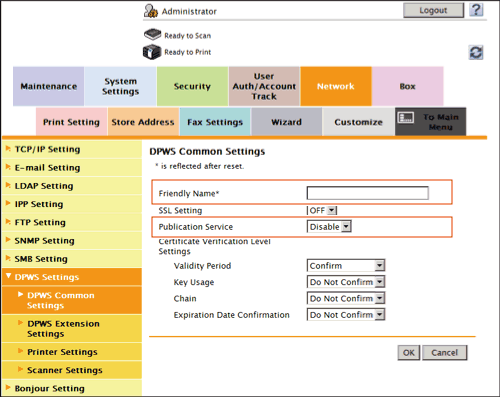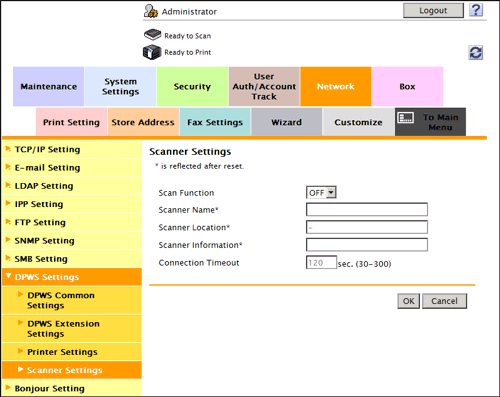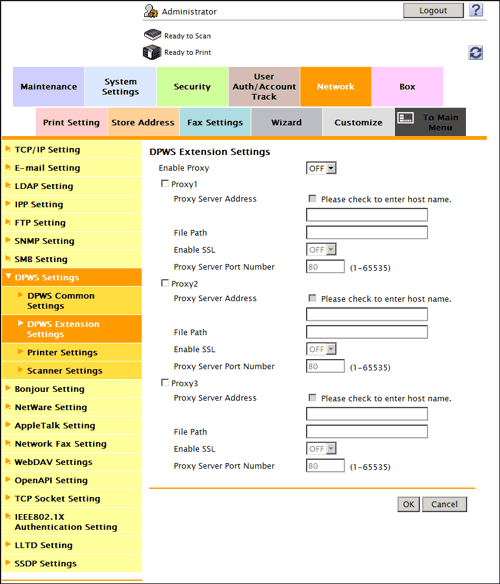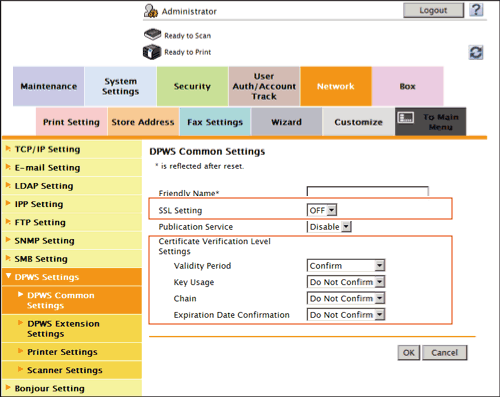
Configuring the WS Scan Environment
Overview
The WS scan transmission is a function that transmits original data scanned on this machine to the computer on the network on the computer loaded with Windows Vista or later (Windows Vista/7/Server 2008/Server 2008 R2).
The computer uses the Web service function of Windows to automatically detect this machine connected to the network and smoothly install this function as a Web service scanner.
HTTP is used for communication between this machine and the computer. Use SSL to encrypt a communication between the this machine and the computer; you can send a file more securely.
When using the WS scan transmission, follow the below procedure to configure the settings.
- Configure settings for connecting to the network such as setting of the IP address of this machine
- For details on configuring the setting, refer to Here.
- Configure the basic settings for the WS scan transmission
- For details on configuring the setting, refer to Here.
- Set the following options according to your environment
Purpose Reference WS scan using the discovery proxyCommunicate with the computer using SSL
Reference
- For details on how to configure settings in the computer side, refer to Here.
Configuring the basic settings for the WS scan transmission
Enable the scan using the Web service. In addition, configure settings used to detect this machine using the Web service, information for this machine as a scanner, and the method to connect to this machine.
- In the administrator mode, select [Network] - [DPWS Settings] - [DPWS Common Settings], then configure the following settings.

Settings Description [Friendly Name]Enter the name of this machine to be displayed when searching for this machine using the Web service through a computer, (using up to 62 characters, excluding spaces).Use a name that helps you easily identify this machine.[Publication Service]When using this machine in one of the following environments, select [Enable].- Environment where NetBIOS is disabled on the computer loaded with Windows Vista or later
- Environment constructed so that only communications using IPv6 are allowed.
Up to 512 destinations can be detected in Publication Service (including detection counts by NetBIOS).[Disable] is specified by default. - In the administrator mode, select [Network] - [DPWS Settings] - [Scanner Settings], then configure the following settings.

Settings Description [Scan Function]Select [ON] to use the WS scan transmission function.[OFF] is specified by default.[Scanner Name]Enter the name of this machine when using it as a WS scanner, (using up to 63 characters, excluding \, !, ,, and a space).[Scanner Location]If necessary, enter the location where to install the scanner, (using up to 63 characters, excluding spaces).[Scanner Information]If necessary, enter scanner information (using up to 63 characters, excluding spaces).[Connection Timeout]Change the time-out time to limit a communication with the computer if necessary.[120] sec. is specified by default.
Using the proxy server
Configure settings for scanning through this machine in the environment where the multicast communication is restricted using the discovery proxy defined by WS-Discovery. Configure the setting if your environment requires the discovery proxy server.
In normal circumstances, to perform scan transmission through this machine using the Web service, the computer must be connected at a location where multicast communication is available for this machine. However, installing the discovery proxy server at a location where unicast communication is available for this machine enables it to perform scan transmission.
In the administrator mode, select [Network] - [DPWS Settings] - [DPWS Extension Settings], then configure the following settings.
| Settings | Description | |
|---|---|---|
[Enable Proxy] | Select [ON] to use the discovery proxy. [OFF] is specified by default. | |
[Proxy1] to [Proxy3] | Register the discovery proxy server used on this machine. | |
[Proxy Server Address] | Enter the discovery proxy server address. Use one of the following formats.
| |
[File Path] | Enter the service name at the path of the URL where the WS-Discovery service is published in the discovery proxy server (using up to 255 characters). | |
[Enable SSL] | When using SSL to encrypt a communication with the discovery proxy server, select [ON]. [OFF] is specified by default. | |
[Proxy Server Port Number] | If necessary, change the port number of the discovery proxy server. Normally, you can use the original port number. When [Enable SSL] is set to [OFF], [80] is specified by default. When [Enable SSL] is set to [ON], [443] is specified by default. | |
Using SSL communication
Communication between this machine and the computer is encrypted with SSL.
To encrypt SSL communication between this machine and the computer, you must set the bidirectional SSL communication between them. Before starting this procedure, confirm the following.
- Name resolution must have been performed in the DNS server.
- If the certificate of this machine is not the one issued by the Certificate Authority (CA), you must register the certificate of this machine in [Trusted Root Certification Authorities] of the computer.
- Create a certificate in the computer side in advance, and associate it with the TCP/IP communication port (default port number: 5358).
To make SSL communications, enable SSL. In addition, specify how to verify the certificate.
In the administrator mode, select [Network] - [DPWS Settings] - [DPWS Common Settings], then configure the following settings.
| Settings | Description | |
|---|---|---|
[SSL Setting] | Select [ON] to make SSL communications. [OFF] is specified by default. This item is displayed when the device certificate is installed on this machine and SSL communication is enabled by selecting [Security] - [PKI Settings] - [SSL Setting] - [Mode using SSL/TLS] in Administrator mode. | |
[Certificate Verification Level Settings] | To verify the certificate, select items to be verified. If you select [Confirm] at each item, the certificate is verified for each item. | |
[Validity Period] | Confirm whether the certificate is still valid. [Confirm] is specified by default. | |
[Key Usage] | Confirm whether the certificate is used according to the intended purpose approved by the certificate issuer. [Do Not Confirm] is specified by default. | |
[Chain] | Confirm whether there is a problem in the certificate chain (certificate path). The chain is validated by referencing the external certificates managed on this machine. [Do Not Confirm] is specified by default. | |
[Expiration Date Confirmation] | Confirm whether the certificate has expired. Confirm for expiration of the certificate in the following order.
[Do Not Confirm] is specified by default. | |
Reference
- In the administrator mode, select [Security] - [Certificate Verification Settings], then configure whether to verify the certificate. The certificate is verified by default. For details, refer to Here.